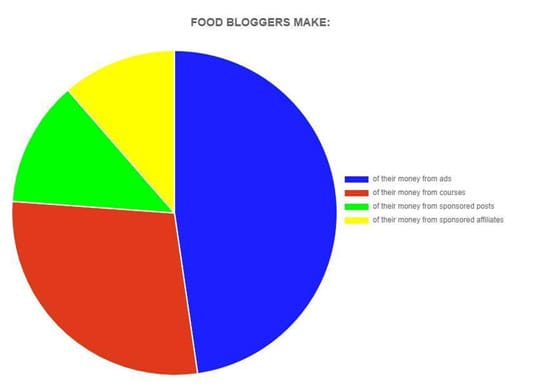The article explores the prospects of food blogging as a lucrative source of income in the modern world. It considers the relevance of the issue, as well as a variety of channels for monetizing food blogs, such as advertising agreements, affiliate marketing, product sales, paid online courses, and others. The piece emphasizes the importance of financial management and diversification of income sources to ensure stability and growth. The author summarizes that food blogging provides a unique opportunity to combine a passion for cooking with financial independence.
The relevance of food blogging as a source of income generation
Food blogs these days have become not just a hobby, but a real business that can provide financial independence. First of all, this is due to the growing interest in cooking and food among a wide audience – with the advent of the Internet and social media, people started looking for recipes and inspiration online. They want to cook delicious, varied and economical food. In this context, cooking blogs provide access to thousands of recipes and tips, which makes them valuable to the audience. According to Google Trends, there has been a steady increase in interest in cooking-related queries in recent years. According to the International Food Information Council’s Food and Health Survey, 43% of survey respondents actively use the internet to search for cooking recipes.
In addition, food content provides many opportunities for monetization. Bloggers earn income from advertising agreements, sponsorships, selling products and services, creating online courses and consulting. This diversification of income sources makes creators financially sustainable. Thus, food blogs provide a unique opportunity to combine a passion for cooking with an income opportunity. With the increasing availability of online platforms, this trend continues to attract both new writers and audiences, making it one of the promising sources of income in today’s world.
First steps in food blogging
When launching a culinary online project, first of all, you should decide on the niche that will become a source of inspiration and earnings. Maybe it’s the peculiarities of Italian cuisine, vegetarianism, or something completely unique: choose what you are passionate about, as your inspiration is passed on to your subscribers. Analyze your target audience, find out their interests – this will help you create content that will attract internet users.
Next, think about your publishing strategy. Be sure to learn the basics of photography and videography, so that the dish in the posts looked appetizing. The quality visual component of publications plays a crucial role in food blogging. Developing a style of presentation, against the backdrop of total digitalization, authentic content is growing in popularity these days. Tell engaging stories about your cooking experiences. Share the secrets and techniques that make each recipe special.
Food Blog Monetization
According to 2021 statistics, the food blogging segment stands out as the most lucrative of all major blogging trends with an average monthly revenue of over $9k. Interestingly, most food designers started creating content primarily for their own satisfaction (75%). However, those who view their online product as a source of monetization highlight several ways to generate income: advertising (42%), selling online courses (25%), hosting sponsored posts (11%), and collaborating with partners (10%).
Monetization of a food blog can be carried out in various ways. Let’s dwell more on the most common channels for generating income from a culinary project.
Advertising agreements and sponsorship:
What it is: Collaboration with brands and companies that pay for advertising placements or sponsor content.
Example: Publishing a post or video featuring a brand’s products, talking about the benefits of their products.
How to earn income: Depends on the arrangement, payment per post, number of views/ likes/ comments, and percentage of sales from referral link.
Affiliate marketing and product sales:
What it is: Recommending products, cooking tools, cookware and other items and then earning commission on sales.
Example: Placing affiliate links to products in a recipe description or review.
How to earn income: Receive commission on sales.
Selling physical products:
What it is: Selling your own products, this could be cooking utensils, spices or seasonings.
Example: Selling author’s seasonings.
How to generate income: Selling products through your online store or e-commerce platforms.
Donations:
What they are: Supporting content financially by subscribers or blogger sponsorship companies.
Example: Creating a page on Patreon for donations from your audience.
How to generate income: Receiving regular or one-time donations from fans, and sponsorship payments from companies.
Participating in food testing and reviewing:
What it is: Evaluating and reviewing foods, restaurants, or culinary events.
Example: Publishing a review of a new restaurant menu or product.
How to earn income: Receiving royalties for evaluating and reviewing products or services.
Publishing your own cookbooks and courses:
What it is: Writing cookbooks, creating online courses and training content for sale.
Example: Publishing a collection of your recipes in book form or creating a cooking course.
How to generate income: Selling books and access to training content.
Collaboration with cafes, restaurants and bakeries:
What it is: Creating your own dishes for catering establishments’ menus with your name on them.
Example: Developing signature dishes for a restaurant or buns with your brand in a bakery.
How to earn income: Contractual royalties or commissions on sales of your dishes.
It is also worth noting that popular food bloggers are often invited to participate in TV and online programs and this also becomes one of the sources of monetization. Choosing the best channels for earning money depends on your niche, audience and personal preferences. Many food bloggers combine several sources of income, which helps them create a stable and profitable cooking blogging business.
Financial Management
When using a blog as a source of income, it is very important to develop a detailed business plan, determine income, expenses and goals for the future. This approach will help you understand what steps you need to take to achieve financial independence. Special attention should be paid to effective income management – develop a budgeting system and keep track of how you spend your earnings. If possible, strive to diversify your sources of income. This will be some kind of safety net: if one of the sources of monetization will be unavailable for external reasons, the blogger will not be left without profit. And of course, invest in the development of your food blog. This may include training, filming equipment, website improvements and promotion. Investments help to increase your potential income.
So, food blogging is not just a passion, it is an opportunity to combine your love for cooking with financial independence. Start by choosing your niche, creating quality content and choosing the best monetization channels. Your path to financial independence in the world of food blogging starts now, and don’t be afraid to experiment, because the culinary arts are endless!
Sources: Statista
15 Food Blog Statistics and Data (Detailed Breakdown), OneHourProfessor , January 30, 2023
https://onehourprofessor.com/food-blog-statistics-and-data/
Food, blogging and the Internet: Some statistics BY HILLARY
Author: Julia Loja, author of the popular food blog The Yummy Bowl
Keywords: food design, food blogging, food blogging, culinary blogging, gastronomic design, food styling
– – – – – – –
Recommended:
- How Effective Is Visual Marketing?
- Essential Tips for Small Business Resilience in Tough Times
- How Important Is Product Promotion?
- What Is A Pitch In An Advertising Agency? 10 Steps Of The Process




